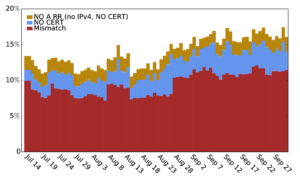The Internet RFC-7858, “Specification for DNS over Transport Layer Security (TLS)”, was just released by the ITEF as a Standards Track document.
From the abstract:
This document describes the use of Transport Layer Security (TLS) to provide privacy for DNS. Encryption provided by TLS eliminates opportunities for eavesdropping and on-path tampering with DNS queries in the network, such as discussed in RFC 7626. In addition, this document specifies two usage profiles for DNS over TLS and provides advice on performance considerations to minimize overhead from using TCP and TLS with DNS.
This document focuses on securing stub-to-recursive traffic, as per
the charter of the DPRIVE Working Group. It does not prevent future applications of the protocol to recursive-to-authoritative traffic.
This RFC is joint work of Zhi Hu, Liang Zhu, John Heidemann, Allison Mankin, Duane Wessels, and Paul Hoffman, of USC/ISI, Verisign, ICANN, and independent (at different times). This RFC is one result of our prior paper “Connection-Oriented DNS to Improve Privacy and Security”, but also represents the input of the DPRIVE IETF working group (Warren Kumari and Tim Wicinski, chairs), where it is one of a set of RFCs designed to improve DNS privacy.
On to deployments!
